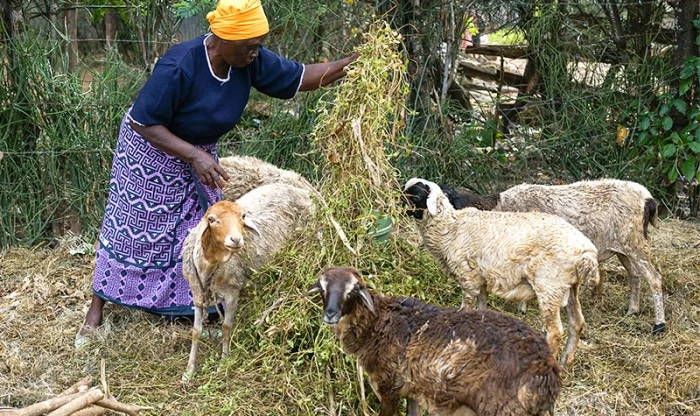Peninah’s children convinced her to go the clinic. They argued that a racing heartbeat and headaches were not normal signs of old age. The 65-year-old Kenyan farmer was reluctant at first, but after taking that first step, she is now going for regular check-ups at the health clinic in Mwea and taking medicine to help keep her blood pressure in check.
The visit to the doctor, the blood test and the pills cost Peninah 300 Kenyan Shillings (about USD 3) in total. The treatment is a good investment, she says, as it allows her to work a full day in her rice field.
Adapting health systems to cope with chronic diseases
Peninah’s experience illustrates the changes that are beginning to improve prospects for long-term care of people with chronic illnesses in rural Kenya. While the country has made great strides in controlling AIDS and other infectious diseases, Kenyans are living longer and chronic diseases such as asthma, diabetes, heart disease and cancer are on the rise. The country has begun adapting its health system, but the challenge remains immense: clinics that were designed to treat acute illness with antibiotics need to be transformed into centers for cost-effective, accessible management of chronic conditions.
“We don’t need to reinvent the wheel for chronic diseases, we can learn from HIV/AIDS,” says Dr. Cyprian Kamau, Head of Health Services, Christian Health Association of Kenya (CHAK). “We need facility-based health systems that are empowered to both diagnose and treat diseases.”
We don’t need to reinvent the wheel for chronic diseases, we can learn from HIV/AIDS. We need facility-based health systems that are empowered to both diagnose and treat diseases.
Dr. Cyprian Kamau, Head of Health Services, Christian Health Association of Kenya (CHAK).
Change is needed because chronic diseases are soon likely to be killing more Africans than infectious diseases like HIV, tuberculosis and malaria, according to Dr. Kamau. In fact, the World Health Organization estimates that by 2030, the death toll from chronic diseases will equal that of infectious diseases, maternal and newborn death, and malnutrition combined.
Until recently, many Kenyans did not even see the point of getting a diagnosis for any chronic condition, as they had no access to medicines to treat them. Sylvia Khamati of the Kenya Red Cross recalls breast cancer campaigns in villages where people were asking: “I have cancer, then what?”
Getting medicines to the people who need them
The picture is slowly changing as affordable treatments are becoming available in rural communities, thanks to programs like Novartis Access. Launched last year, Novartis Access focuses on the affordability and availability of 15 on- and off-patent medicines addressing the four main types of chronic diseases – cardiovascular diseases, diabetes, respiratory diseases, and breast cancer.
The improved access to treatment has begun to shift attitudes among Kenyans. For instance, on a typical day, the clinic in Mwea where Peninah receives treatment has over 300 people waiting for visits, checkups and prescriptions, the vast majority related to chronic conditions.
“Some people have even become willing to educate the rest of the community about chronic conditions,” according to Dr. Jonathan Kiliko, Head of Customer Service at the Mission for Essential Drugs & Supplies (MEDS).

Peninah is typical of the change in attitude toward chronic diseases among low-income people in Kenya. She now chairs the local women’s group in Kiandegwa village, which meets weekly and discusses healthcare topics, from basic sanitation to chronic diseases.
To make the most of this new awareness and willingness to treat, Kenya needs additional investment in training and skills development. Novartis, the Christian Health Association of Kenya, the Kenyan Conference of Catholic Bishops and the Kenyan Red Cross have joined forces to build capacity to diagnose and manage chronic diseases in local facilities across Kenya. This includes plans to reach one million people with education campaigns on diabetes in the next two years. Other activities will include campaigns to screen and diagnose people for diabetes and hypertension in health facilities and communities, as well as training for healthcare workers.
Most Kenyans with modest incomes have to pay for treatment themselves, so expensive medicines can be an obstacle to long-term care of chronic diseases. Novartis Access medicines can help address that issue for some people. The cost for patients should not exceed USD 1.50 per treatment per month. For some, however, even that is unaffordable and government funding will be needed to bridge the gap, according to Kamau.
The first Novartis Access treatments reached rural health facilities in three counties in Kenya in February 2016 and the program is expected to be rolled out to all 47 counties by the end of 2017. To date, the country has ordered more than 100,000 monthly treatments for five Novartis Access medicines across four disease areas.
For Peninah, the change is profound. She has gone from being fatalistic about her disease to believing that she could have many more years of productive life in her beloved rice fields.
This article is based on discussions at a dialogue held by Novartis Access in conjunction with the World Health Assembly in May 2016.
Watch highlights from the event.
Making progress against #NCDs doesn't mean reinventing the wheel. #NovartisAccess shares how



